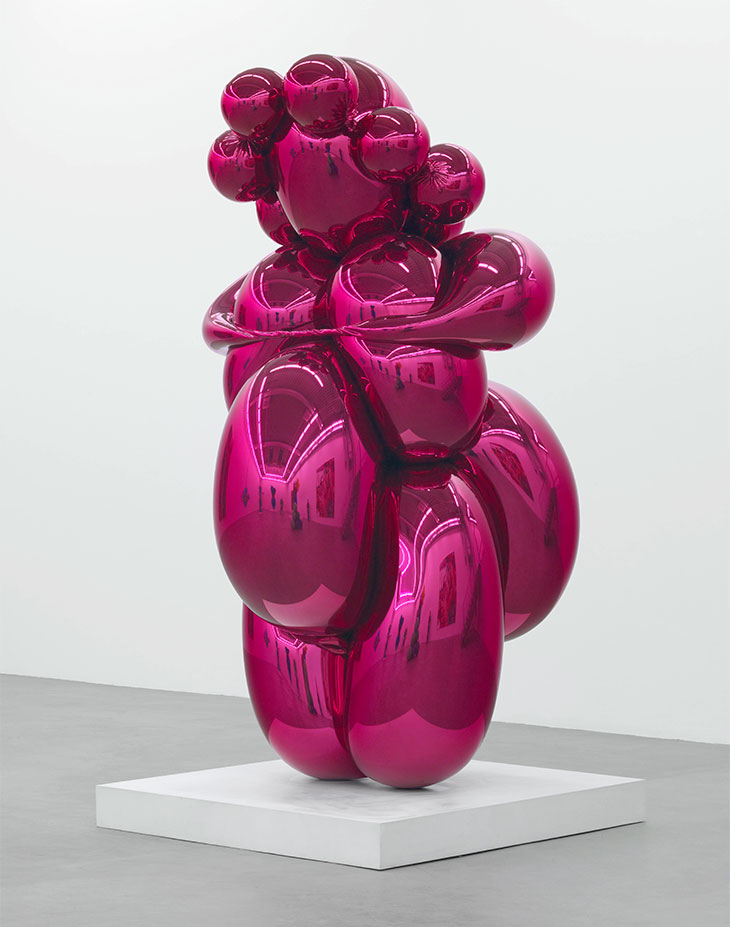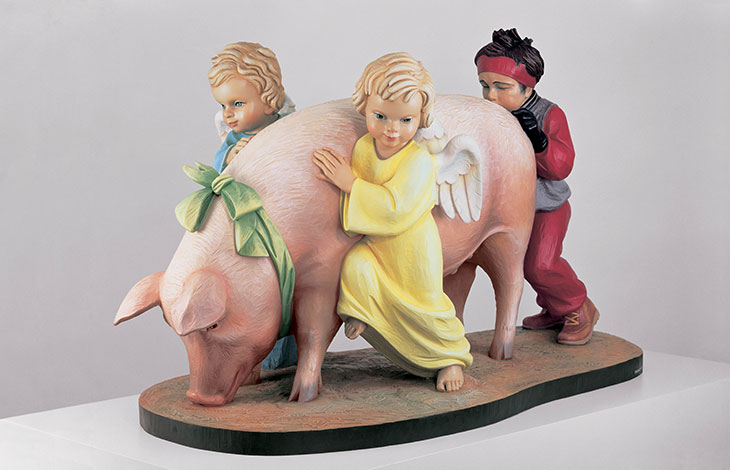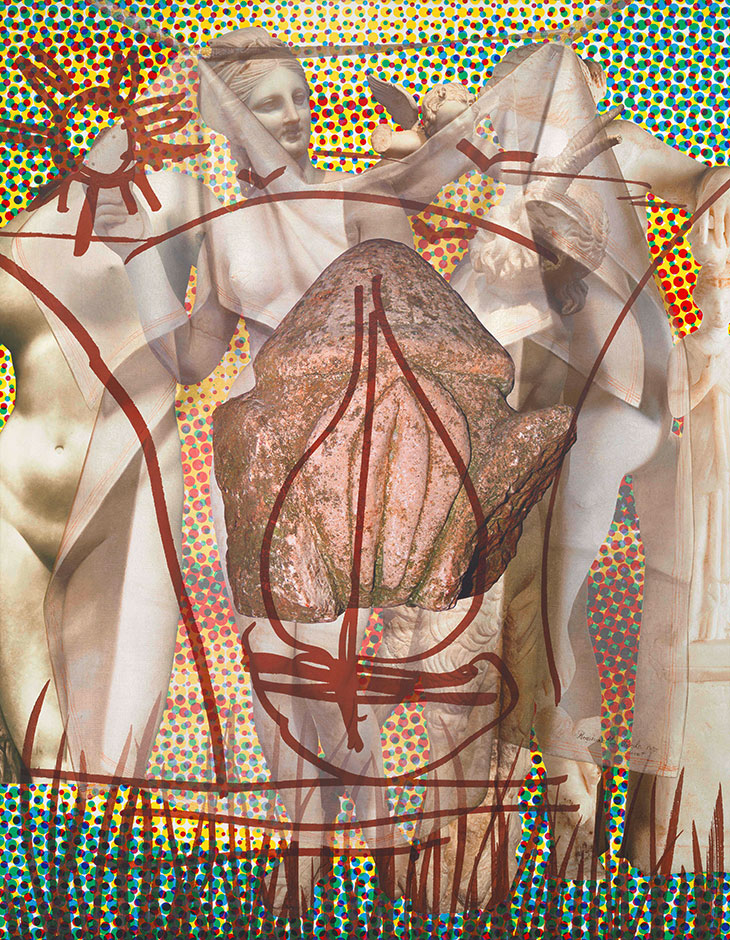The first image to greet the visitor at the entrance to this exhibition, arranged across three galleries in Oxford’s Ashmolean Museum, is a life-sized photo portrait of Jeff Koons in his New York studio. Standing on a plinth, he gazes out at the viewer, one hand holding a deep-blue glass sphere that, like the mirror in the ‘Arnolfini Portrait’, encapsulates the room around him. In the background, three assistants, their faces and hands hidden, work on a canvas from his Antiquity series. As this photograph suggests, Koons is less an artist, in the sense of a craftsman, than a creative director – and one who is careful of his image.
The images of both Koons and the Ashmolean are at stake in this exhibition of 17 of his works, which he co-curated with Norman Rosenthal. It is a coup for the university museum to have secured a figure like Koons, a superstar (if a controversial one) of the contemporary art world. As stated on his website, in 2017 Koons was ‘[m]ade an Honorary Member of University of Oxford’s Edgar Wind Society for Outstanding Contribution for Visual Culture’. He flew over to Oxford to accept membership of this society of undergraduate art enthusiasts; it was here that he would meet, and ultimately collaborate with, the museum’s director, Alexander Sturgis.
Balloon Venus (Magenta) (2008–12), Jeff Koons. The Broad Art Foundation, Los Angeles. Photo: Marc Domage. Courtesy Almine Rech Gallery; © Jeff Koons

Three of Koons’ early successes – a basketball floating in a tank, a silver steel bunny, and a polychromed wood group centred on a pig – are presented in the first gallery. But perhaps the most compelling work on display comes later: the Balloon Venus (Magenta), made between 2008–12. This is a computer-imaged replica of a single balloon twisted into the shape of the ‘Venus of Willendorf’, an 11cm-tall terracotta female statuette of ample proportions, possibly a fertility goddess, dating from around 30,000 years ago. Koons’ version is 2.59m tall, weighs about 1.5 tons, and is cast in ‘mirror-polished stainless steel’, a medium for which he has become well known. The magenta Venus is, in a paradox typical of luxury goods, ‘one of five unique versions’ – Koons has produced others in yellow, red, orange and violet. However, it is difficult to imagine a better colour for this piece than a gloriously brash fuchsia: together with the polished and bulging breasts, buttocks and belly, it captures something of the totemic power of the original, and is strangely hypnotic.
Ushering in Banality (1988), Jeff Koons. © Jeff Koons

The poster girl for the exhibition is the Seated Ballerina (2017). She, along with a two-figure group also on view, is a replica of small porcelain figurines designed by the Ukrainian sculptor Oksana Zhnykrup and manufactured in the Kyiv Experimental Ceramic Art Factory in the 1960s. Like the Balloon Venus, Koons’ ballerinas are much larger than their models – well over two metres tall. But not all artefacts are improved by magnification, or replication in steel. While the limbs of the original dancers were milky and delicate, Koons has made them a glaring salmon-pink, in monstrous dimensions. Presented alongside these figures are four canvases from Koons’ Antiquity series. Antiquity (Forest) (2010–13) borrows its background from a painting by the obscure, desperately self-promoting American artist Louis Eilshemius (1864–1941), of whom Koons is apparently a ‘huge fan’. Superimposed on this is an image of an erotic Hellenistic sculpture of Aphrodite, Pan and Eros, on top of which in turn is a Dalí-esque sketch by Koons himself – a sort of artistic graffiti – of a ship at sea, which is also intended to represent a woman’s genitals.
In Antiquity 4 (Dots) (2010–13), a similar scene is overlaid with an image of a ‘prehistoric sculpture’ of a vulva and penis head. But of all the information Koons could have chosen to reveal about this unusual object, the catalogue says nothing except that he ‘bought it off the internet’. This is telling. Koons claims that ancient sculptures he replicates are ‘part of our shared cultural memory’. But he also reassures his viewer that ‘you don’t have to bring anything to [the painting] other than your own life experience because it’s really about you and your interactions’. In other words, the past is interesting only in so far as it enables the viewer to be ‘visually stimulated from images’.
Antiquity 4 (Dots) (2010–13), Jeff Koons. Photo: Tom Powell Imaging. © Jeff Koons

A similar attitude seems implicit in the works on view from the Gazing Ball series. These include replicas of classical statues and paintings by Old Masters on to which a glass sphere, like the one Koons holds in his self-portrait, has been affixed. The series aims to capture the viewer and artwork in the same reflective surface. As the catalogue tells us, ‘[t]his experience is about you – your desires, your interests […] your relationship with this image’. The purpose of art – somewhat disappointingly – is to make us think endlessly about ourselves.
The overall impression is that, for all their technical skill and verbal hype, Koons’ works are closest in spirit to the original collection for which the Ashmolean was founded: a ‘cabinet of curiosities’. What fascinates is not their (dubious) status as high art, but their obsession with the vanities and insecurities of their consumers. After the exhibition, the gift shop offers the aspirational visitor the chance to buy into the Koons myth. A porcelain Balloon Dog (Yellow), one of a limited edition of 2,300, may be purchased for the modest sum of £9,996 – just a little more than a year’s tuition at Oxford.
‘Jeff Koons’ is at the Ashmolean, Oxford until 9 June.



